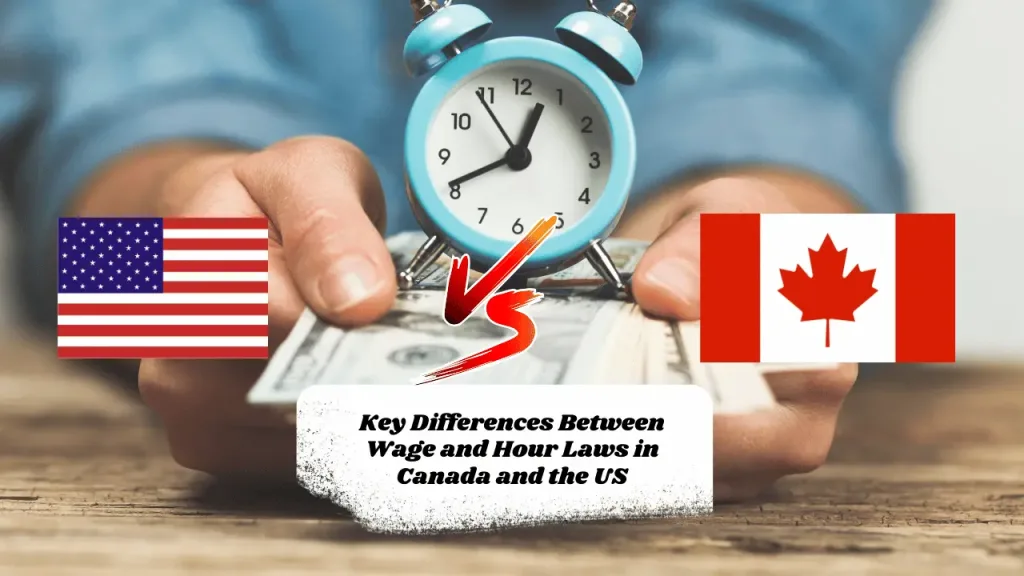Key Differences Between Wage and Hour Laws in Canada and the US
Wage and hour laws in Canada and the United States differ significantly due to variations in federal structures, labor regulations, and workplace standards. Below is a comparison highlighting key distinctions:
1. Regulatory Structure
- United States: Wage and hour laws are primarily governed by the Fair Labor Standards Act (FLSA) at the federal level, with individual states allowed to implement stricter regulations.
- Canada: Labor laws are regulated by provincial and territorial governments, except for federally regulated industries like banking, telecommunications, and transportation, which fall under the Canada Labour Code.
2. Minimum Wage
- United States:
- The federal minimum wage is $7.25 per hour (as of 2025). States and municipalities can set higher minimum wages.
- Example: California’s minimum wage is $15.50 per hour (2023).
- Canada:
- Minimum wages are set by provinces and territories and are generally higher than the U.S. federal minimum.
- Example: Ontario’s minimum wage is $16.55 per hour (2023), and Alberta\u2019s is $15.00 per hour.

3. Overtime Pay
- United States:
- Federal law mandates overtime pay at 1.5 times the regular rate for hours worked over 40 hours per week.
- Some states have additional rules, such as daily overtime for work over 8 hours.
- Canada:
- Overtime thresholds vary by province:
- In Ontario, overtime pay applies after 44 hours per week.
- In Alberta, overtime applies after 8 hours per day or 44 hours per week, whichever is greater.
- Overtime pay is typically 1.5 times the regular wage.
- Overtime thresholds vary by province:
Related article for you:
How Long Does A Wage And Hour Investigation Take? How They Are Initiated and How to Prepare?
4. Workweek and Hours
- United States:
- The standard workweek is 40 hours under federal law.
- Break requirements vary by state and are often not mandatory under federal law for adult workers.\n
- Canada:
- The standard workweek and hours vary by province:
- In Quebec, the standard is 40 hours per week.
- In British Columbia, employees are entitled to an unpaid 30-minute break for shifts longer than 5 hours.
- Breaks and rest periods are more consistently regulated in Canada.
- The standard workweek and hours vary by province:
5. Paid Leave and Vacation
- United States:
- The FLSA does not require employers to provide paid vacation, sick leave, or statutory holidays. These benefits are typically negotiated or offered voluntarily.
- Canada:
- Paid leave is legislated at the provincial/territorial level:
- Most jurisdictions mandate a minimum of 2 weeks of paid vacation after one year of service.
- Employees are entitled to paid statutory holidays, such as Canada Day and Thanksgiving.
- Paid leave is legislated at the provincial/territorial level:
6. Enforcement and Employee Rights
- United States:
- Enforcement is carried out by the U.S. Department of Labor (DOL) Wage and Hour Division.
- Class action lawsuits for wage violations are common.
- Canada:
- Provincial labor ministries or boards enforce compliance.
- Workers can file complaints with government agencies, often resulting in quicker resolutions compared to U.S. litigation.
7. Parental Leave
- United States:
- The Family and Medical Leave Act (FMLA) provides up to 12 weeks of unpaid leave for eligible employees but does not guarantee paid parental leave.\n
- Canada:
- Parental leave is far more generous, with federally administered Employment Insurance (EI) offering up to 18 months of partially paid parental leave, depending on the province and employment terms.
8. Union Influence
- United States:
- Union membership has declined, and “right-to-work” laws in some states weaken unions’ power.\n
- Canada:
- Unionization rates are higher, particularly in public sectors, providing stronger collective bargaining for wage and hour protections.
Conclusion
In summary, Canadian wage and hour laws are often more protective of workers, with higher minimum wages, legislated paid leave, and more consistent enforcement. In contrast, the United States relies on state-level regulations to supplement federal laws, leading to greater variability in worker protections. Employers and employees in both countries must stay informed of local regulations to ensure compliance.
About the Author

Sarah Klein, JD, is a former employment attorney who has advised clients on wrongful termination, workplace discrimination, wage disputes, and employee rights. At All About Lawyer, she writes practical, legally sound guides to help workers understand labor laws and stand up for fair treatment at work.
Read more about Sarah
